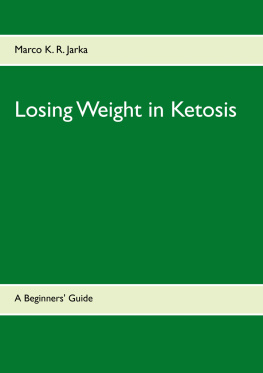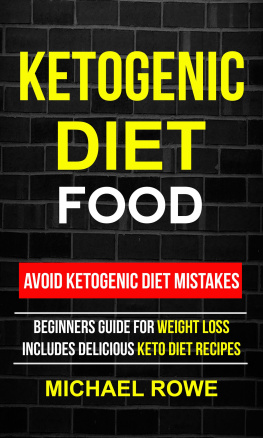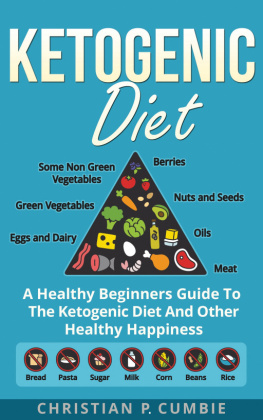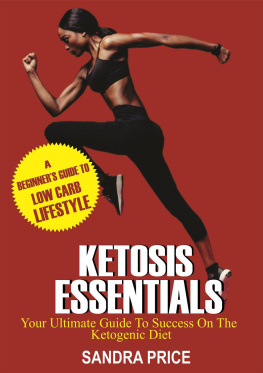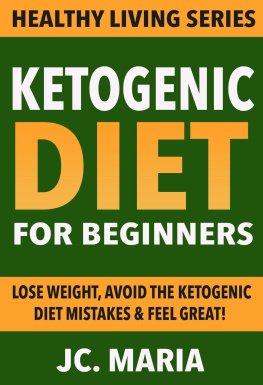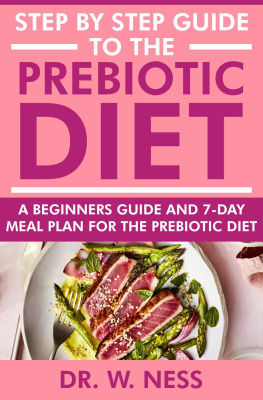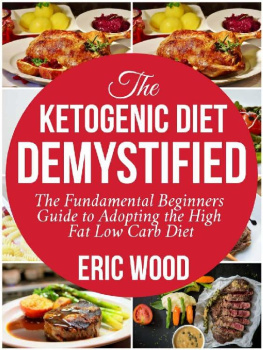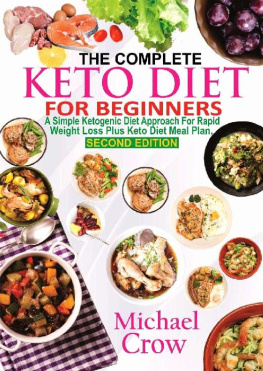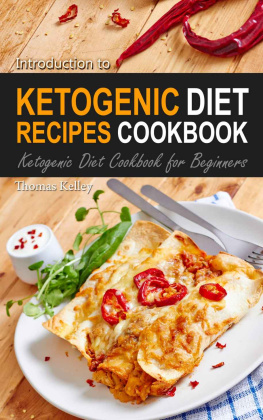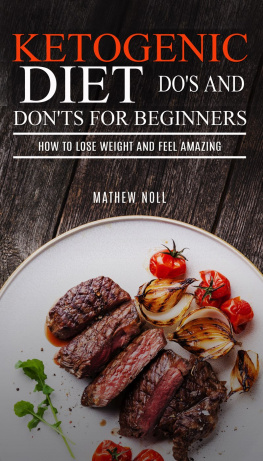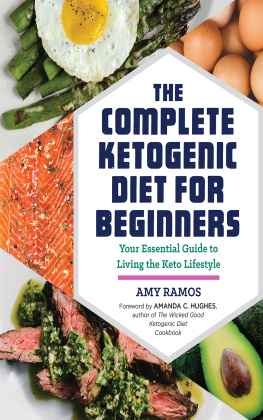Bibliographic Information of the Deutsche Nationalbibliothek:
The German National Library has registered this publication in the German National Bibliography; detailed bibliographic information can be found on the Internet at http://dnb.dnb.de.
2nd Edition 2015
2015 Marco K. R. Jarka
Production and publishing house:
BoD Books on Demand GmbH, Norderstedt
ISBN: 978-3-7386-6930-5
Table of Contents
Preface
What is ketosis and what does "low carb" mean? Low carb is a form of diet in which the consumption of carbohydrates is more or less severely restricted. Within that context, the ketogenic diet is the most extreme form of low carb and almost no carbohydrates are consumed, forcing the metabolic process to change how it generates energy completely. Certain tissues in our body, which would otherwise be supplied with carbohydrate module glucose thus extract their energy from ketone bodies, which, in the absence of carbohydrates, are produced in excess. Ketone bodies, found for example in urine, are the namesake of the "ketogenic" diet and the metabolic state of "ketosis". Ketosis itself can be seen as a type of indicator and just one of many metabolic changes that occur as a result of the lack of carbohydrates.
In addition to a few other benefits, combining a ketogenic diet with a negative balance of energy is a very effective method for burning body fat. Low-fat, carbohydrateheavy reductive diets simply cannot compete and always result in a considerable loss of valuable lean mass and lower energy levels. That, in turn, causes the so-called yo-yo effect common after a diet. Thus, a ketogenic diet is the better choice for effectively reducing body fat.
So far so good. But, what about food selection on lowcarb diets? Protein mast, dizzying uric acid intake and as much sausage and cheese as you want? That invokes justified doubt about the plan and gives low-carb, specifically including ketogenic, diets the reputation of being likely to have a negative impact on one's health.
Yet, it doesn't have to be that way. In this book, we find out how the omission of carbohydrates as part of a reductive, ketogenic diet can be properly performed. You will find information on how you can force your body to burn fat by changing your metabolism. Purposefully. Whether you simply want to get rid of a few pounds or you want to be able to show off a six pack, with or without exercise and regardless of age and gender. During this process, proper attention will be given to selecting appropriate foods to ensure you cover all your dietary needs despite the diet.
Does that sound good? However, this book makes no promises such as "Lose 10 pounds of belly fat in a week", "Never count a single calorie" or "Eat whatever you want". This book focuses on giving you a solid diet concept with realistic goals. Much will actually be required of you at the beginning as well. And, depending on how carb-rich your diet was before this diet, the demands may even be quite large.
What to expect during the diet:
- Extensive changes in your metabolism as a result of the omission of carbohydrates: the transition can be unpleasant and the omission of carbohydrates will be very noticeable during this phase. Duration: a few days to 2 weeks
- Weight loss phase in ketosis: you no longer feel hungry or full or even have increased performance, slow and steady weight loss of 300-800 g of fat/week until your target weight has been reached
- Maintenance phase: Finding a sound energy balance, while maintaining a ketogenic diet or other type of diet
Before we get started, here are a few tips on using this guide:
All information in this book reflects the author's current state of knowledge and was carefully examined prior to publication. However, medical advice cannot be provided. Please discuss any medical questions you may have related to changing your diet with your physician. Some metabolic issues may render it impossible for you to follow the diet described in this book.
On the other hand, you will not need any prior knowledge. The key basics necessary for a practical application of this diet will be explained. To keep things simple, I have also chosen not to include explanations of the extensive theoretical connections associated with the matter at hand.
Now, I wish you happy reading and much success with your new diet!
Ihr Marco K. R. Jarka
The Most Important Connections
The Purpose of Diet
The physiological purpose of diet is to delivery nutrients and water in order to maintain metabolism and the functions of the body. An individual's energy and nutrient requirements depend on their age, gender, physique, degree of activity, as well as a few other factors. Nutrients are provided by supplying food and water. The major molecules of the digestible parts of food are broken down into low-molecular units in our digestive system and, e.g. reorganized into nutrients our bodies can use or are used to produce energy. Certain smaller particles can be absorbed without being broken down and can, e.g. be supplied directly for the fulfillment of their specific purpose. Components and metabolic products that cannot be digested are excreted.
Composition of Our Food
The composition of our food can be divided into the general categories of macronutrients, micronutrients and water. Besides water, macronutrients make up the largest share of the substances we take in. These are substances such as carbohydrates, proteins and fats. While proteins and fats also serve as nutrients, all three types of nutrients can actually be turned into energy. Micronutrients are understood as vitamins, mineral nutrients and trace elements. Fibers are indigestible compound sugars that cannot be broken down and absorbed in the human small intestine. Foods from different foods groups mainly tend to have the characteristics of micronutrients and macronutrients, as well as widely varying shares of water.
It all depends on the nutrients!
From a nutritional physiological perspective, it is the type and quantity of the nutrients we supply through food that are decisive for our organism. The different foods themselves merely serve as potential suppliers. In our impressively complex organism, a wide variety of substances are used to maintain the manifold tasks and functions it performs. Many of these substances the organism itself produces from other substances. However, there are a few substances it cannot produce. These are the so-called essential nutrients. These nutrients have to be supplied in sufficient quantity from an outside source, even during a reductive diet.
For an adult human, the essential nutrients are composed of eight amino acids, two fatty acids, a few mineral nutrients and trace elements, as well as all vitamins; although vitamin D is an exception and can, in addition to oral intake, be produced in the skin if exposed to sufficient sunlight. Official recommendations for required intake exist for most essential nutrients, such as the Recommended Dietary Allowances (RDAs) published by the Food and Nutrition Board of the Institute of Medicine. They also provide recommendations for the total amount of protein, water and share of macronutrients that should be consumed, as well as guidelines for energy intake. Among the factors taken into consideration are age and gender. Good nutrition tables list the content of the various micronutrients and macronutrients, the water content and the physiological calorific value (digestible energy content) in a food. Nutrition facts on food packaging are generally limited to the energy content and how much of the three macronutrients - carbohydrates, proteins and fats - they contain. The energy content of a food, on the other hand, depends on how much of those three macronutrients it contains. Even alcohol provides energy. Regardless of the foods they originate from, these nutrients all provide the following energy:
Next page
